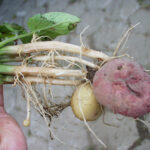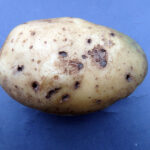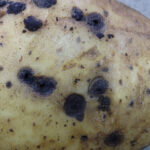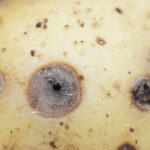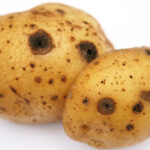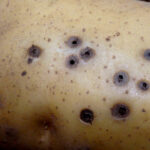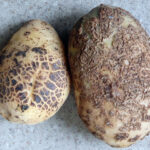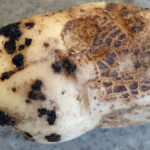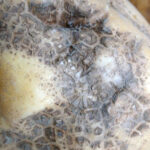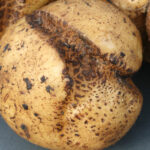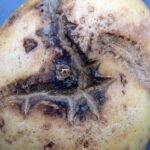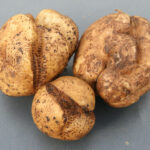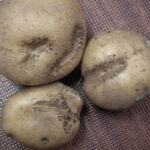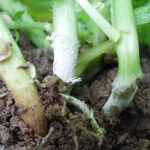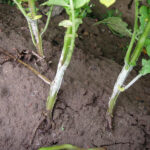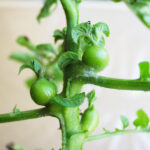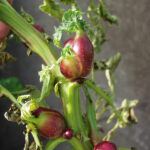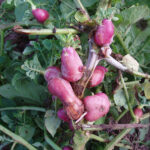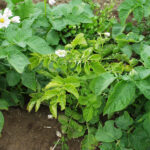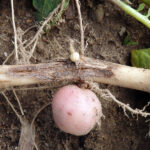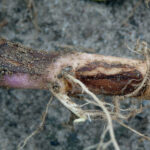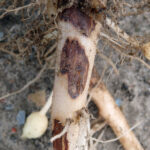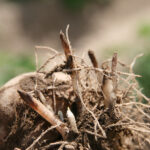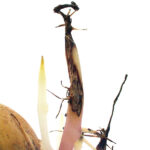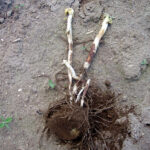Polish name: Rizoktonioza ziemniaka
English name: Rhizoctonia stem canker / Black scurf / Dry core
Kod EPPO: RHIZSOL
Perpetrator of the disease:
- Fungus Rhizoctonia solani
Gallery
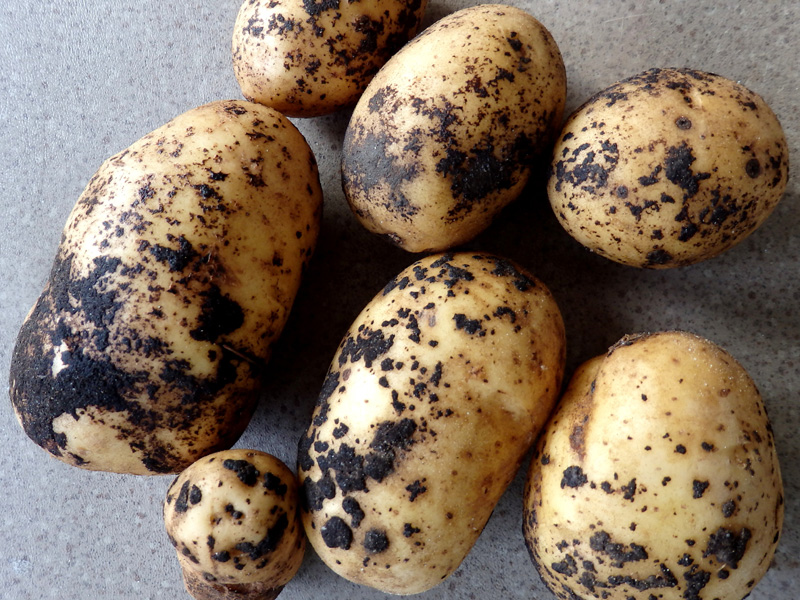
Potato Rhizoctonia Disease. Clusters of sclerotia on the tuber.
(photo by J. Osowski)
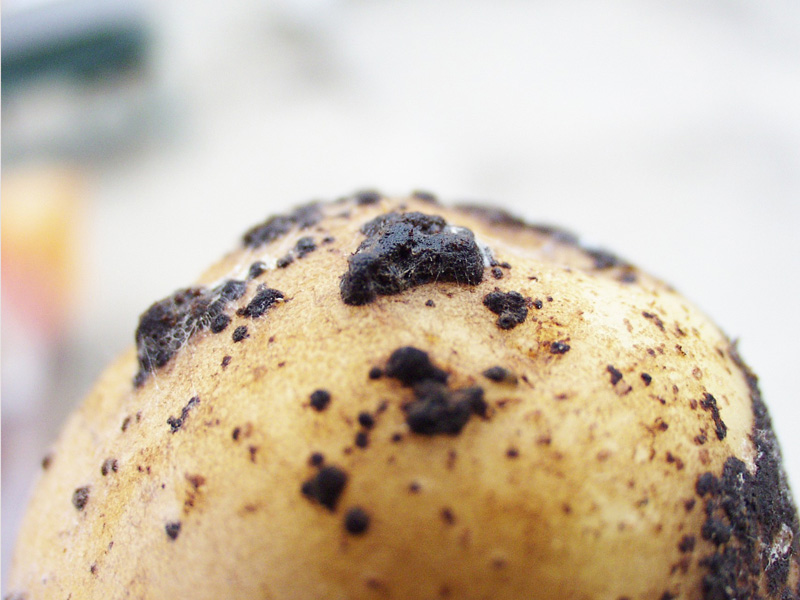
Potato Rhizoctonia Disease. Clusters of sclerotia on the tuber.
(photo by J. Osowski)
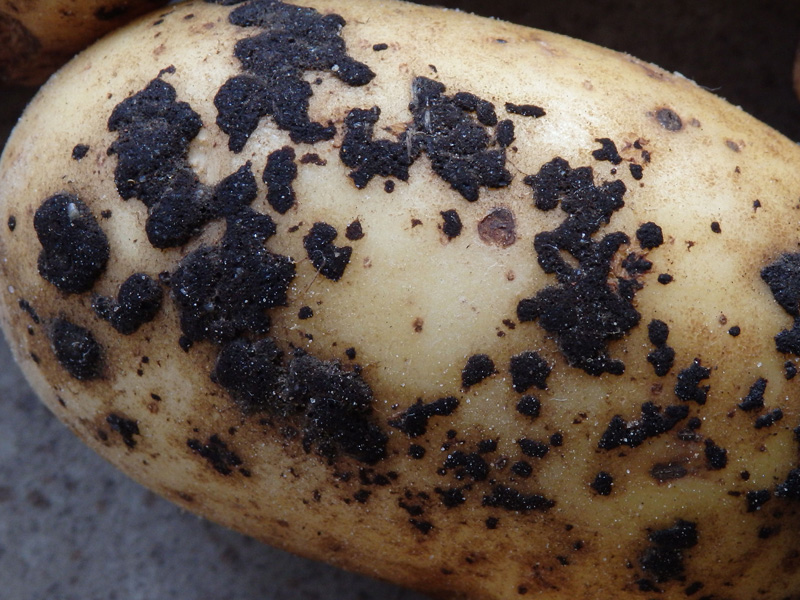
Potato Rhizoctonia Disease. Clusters of sclerotia on the tuber.
(photo by J. Osowski)
- Rizoktonioza ziemniaka. Zdrowe łodygi po zaprawianiu bulw środkami ochrony roślin (fot. S. Wróbel)
- Objawy żerowania drutowców na bulwie ziemniaka (fot. J. Osowski)
- Rizoktonioza ziemniaka. Objawy dry core (korkowatość) na bulwie (fot. J. Osowski)
- Rizoktonioza ziemniaka. Objawy dry core (korkowatość) na bulwie (fot. S. Wróbel)
- Rizoktonioza ziemniaka. Objawy dry core (korkowatość) na bulwie (fot. S. Wróbel)
- Rizoktonioza ziemniaka. Objawy dry core (korkowatość) na bulwie (fot. J. Osowski)
- Rizoktonioza ziemniaka i parch zwykły – porównanie objawów (fot. J. Osowski)
- Rizoktonioza ziemniaka. Deformacje bulw i skupiska sklerocjów (fot. J. Osowski)
- Rizoktonioza ziemniaka. Deformacje bulw (fot. J. Osowski)
- Rizoktonioza ziemniaka. Deformacje bulw (fot. Wróbel)
- Rizoktonioza ziemniaka. Deformacje bulw (fot. J. Osowski)
- Rizoktonioza ziemniaka. Deformacje bulw (fot. S. Wróbel)
- Rizoktonioza ziemniaka. Deformacje bulw (fot. J. Osowski)
- Rizoktonioza ziemniaka. Opilśń łodygowa (fot. S. Wróbel)
- Rizoktonioza ziemniaka. Opilśń łodygowa (fot. J. Osowski)
- Rizoktonioza ziemniaka. Bulwki powietrzne (fot. S. Wróbel)2
- Rizoktonioza ziemniaka. Bulwki powietrzne (fot. S. Wróbel)
- Rizoktonioza ziemniaka. Bulwki powietrzne i opilśń łodygowa (fot. J. Osowski)
- Rizoktonioza ziemniaka. Więdnięcie liści w części wierzchołkowej rośliny (fot. S. Wróbel)
- Rizoktonioza ziemniaka. Suchy proces gnilny przypominający próchnienie drewna (fot. J. Osowski)4
- Rizoktonioza ziemniaka. Suchy proces gnilny przypominający próchnienie drewna (fot. J. Osowski)3
- Rizoktonioza ziemniaka. Suchy proces gnilny przypominający próchnienie drewna (fot. J. Osowski)2
- Rizoktonioza ziemniaka. Suchy proces gnilny przypominający próchnienie drewna (fot. J. Osowski)
- Rizoktonioza ziemniaka. Gnicie kiełków (fot. S. Wróbel)2
- Rizoktonioza ziemniaka. Gnicie kiełków (fot. S. Wróbel)
- Rizoktonioza ziemniaka. Gnicie kiełków (fot. J. Osowski)
Characteristics and description of the disease
The disease occurs in all potato cultivation regions, and its severity depends largely on the weather conditions during the growing season. Losses caused by the occurrence and development of Rhizoctonia disease can reach up to 50% of the yield. In the course of Rhizoctonia, three forms can be distinguished: sclerotia formation on tubers, germination of sprouts, and rotting of the base of the stem. Each of these forms occurs at different times and on different parts of the plant. They can represent consecutive phases of disease development, but they can also occur independently of each other.
Sclerotia Formation on Tubers:
On the surface of the tuber, black, granular scabs form, ranging in diameter from a few to several millimeters and thickness up to 3-5 mm. They have various shapes and can merge, forming large clusters. These are sclerotia, which serve as the survival form of the pathogen and, at the same time, a source of infectious material for the next season. These sclerotia can be easily scraped off the skin surface. Potatoes covered with sclerotia are largely unsuitable for planting material but can be used for feed and industrial processing.
Germination of Sprouts:
This is the most dangerous form of the disease, and losses caused by its development can reach up to 25% of the plant population in the field. Brown necrotic spots appear on the surface of the sprout, which, as they develop, lead to withering and rotting of the sprout. The plant, responding to the destruction of the first strong sprouts, produces new ones, which, however, are weaker and thinner and can also be affected. Damage to the sprouts significantly delays emergence, and on the plantation, there are empty spaces and plants that are weaker and have fewer shoots compared to healthy ones.
Rotting of the Base of the Stem:
This form of the disease appears later and is a rotting process in which decomposing brown tissues are dry and resemble decaying wood, hence the name of this form. This process occurs only on parts of the stems covered with soil. The destruction of underground stem parts leads to disturbances in the transport of water and assimilates. As a result of these disturbances, secondary symptoms of rotting of the base of the stem can be observed on the above-ground part of the potato. Disruption in the transport of water and mineral salts causes the wrinkling and rolling of leaves in the top part. These symptoms may resemble the primary symptoms of leaf roll, but in the case of Rhizoctonia, the leaves are soft, not leathery and rigid. Another symptom resulting from the destruction of conducting bundles is the formation of so-called aerial tubers in the leaf axils, which arise due to difficulties in the transport of assimilates. After the rows close, when abundant rainfall occurs, brownish-white powdery mildew appears on the stems just above the soil surface. This is the sexual form of the pathogen.
Deformities of Tubers:
The disease, developing in the underground parts of the plant, damages not only the stems but also stolons, leading to the dwarfing and deformation of tubers. These symptoms can sometimes resemble a flat form of common scab – in the photo, the tuber on the right with symptoms of common scab. In recent years, another symptom of tuber damage has become more common. This is corkiness (dry core). Circular, slightly depressed, sharply defined brown spots with a diameter of 3-6 mm appear on the skin. The skin inside the spot is often torn and covers the hole where a corky core is located. This may resemble symptoms of wireworm feeding, but unlike Rhizoctonia, the holes are not covered with skin and often go deeper.
Factors Favoring Disease Development:
Cool, moist spring. Too deep planting, especially in unheated soil. Use of infected seed potatoes.
Prevention:
Use healthy, certified seed potatoes. Planting timing that considers local soil and climate conditions: when the soil temperature rises to 8-10°C. Planting potatoes on the same field after a 4-5-year break to naturally reduce the amount of infectious material in the soil. Chitting and stimulating seed potatoes, allowing for faster plant growth and planting them earlier, as well as shortening the germination period. Harvesting tubers after skin maturity. Do not prolong the time between desiccation and harvest, as it will promote the settling of fungal sclerotia on tubers. Treating tubers before planting (photo 11) if more than 20% of the seed potatoes show symptoms of scab. The planting method should be adapted to the technical capabilities of the farm and local soil and climate conditions. Treatment using professional equipment, such as a planter-mounted treater, Mantis and Mafex devices, or ULV technique. Treatments include azoxystrobin, flutolanil, and pencycuron.
Compiled by: Dr. Eng. Jerzy Osowski

